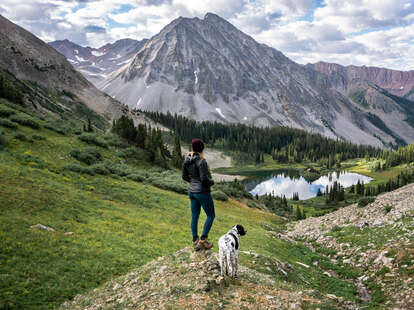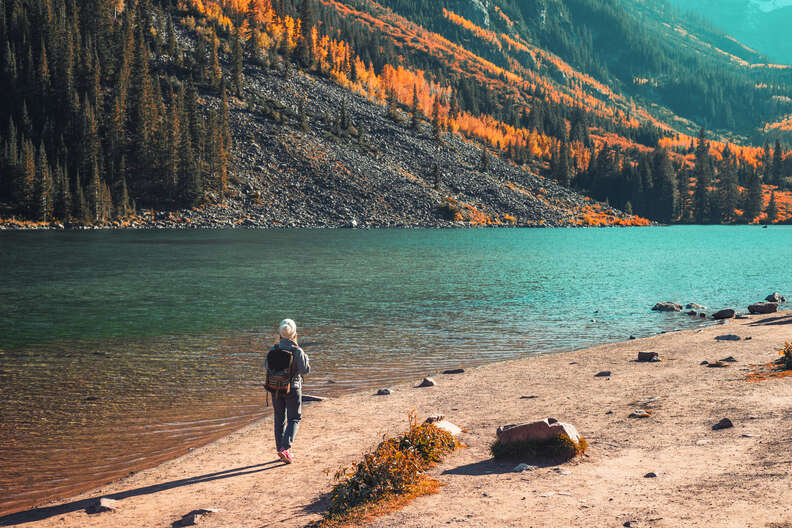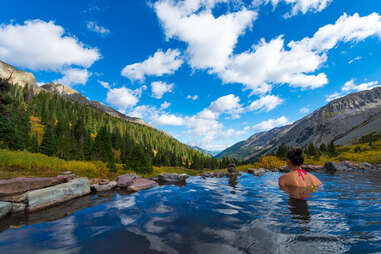
America's Most Photographed Mountain Peaks Loom Over Aspen's Best Hikes
How to truly rock the Bells.
In Colorado’s Rocky Mountains lie the two "14ers"—Maroon Peak and North Maroon Peak—that together comprise the Maroon Bells: the most-photographed peaks in North America. Nestled into the Elk Mountains near Aspen and dotted with hiking trails and fishing holes, the iron-rich Maroon Bells are so sublime that more than 300,000 people typically descend upon them in the summer months alone.
But this is hardly a one-season wonder. Leaf-peepers make the trip when the aspens erupt each fall. Pristine slopes around Aspen draw snowbirds from around the world each winter, and wildflower fields carpet the mountains each spring. And with summer's thaw comes hiking trails bound challenge even the most practiced climbers.
Curious? Perhaps a look at a few of the most stunning spots will inspire your next trip—especially if you’re the only one in the friend group who hasn’t had a Maroon Bells photoshoot yet.

The Maroon Bells are surrounded by the Maroon Bells-Snowmass Wilderness Area. The area contains legendary trails like Four Pass Loop, a 26-mile backpacking circuit that summits four separate mountain passes towering above 12,000 feet. Late summer is the best time of year to make the trek, when churning snowmelt isn’t making river crossings as treacherous. There’s no fee required to hike this one through, but overnight campers are asked to self-register at the trailhead kiosks.

A relic of the late 1800s, Crystal Mill looks like something that should only exist in The Lord of the Rings or a Windows 95 screensaver loop. Seriously—look at this thing. There used to be an accompanying wooden waterwheel, which helped generate power to ventilate nearby silver mine shafts, but time has left us only the mill itself; the nearby town of Crystal is a ghost town. Today, Crystal Mill is on the National Register of Historic Places, and accessible by trail in the summer and fall.

Figuring heavily into all those prized Maroon Bells pics, Maroon Lake is best enjoyed in the summer months by hiking in via the Maroon Lake Scenic Trail and pausing at the ever-popular Maroon Bells Scenic Area. (Prime trout fishing kicks off around dawn and dusk, too.) Reservations are now required to visit Maroon Bells and associated trailheads by vehicle or shuttle bus, including overnight parking for backpackers.

Not far from Maroon Lake lies Crater Lake, which you can hike into from the same trail after continuing past Maroon Lake and crossing the valley between Sievers Mountain and Pyramid Peak (more on those in a minute). Crater Lake is the other essential location for a photoshoot—and a picnic—thanks to its utterly iconic view of the Maroon Bells. And if routes like the Maroon Lake Trail seem too easy for you enterprising hikers out there, you won’t be disappointed by everything that comes next.

Got your bear spray and water-filtration gear? Hit the Conundrum Creek Trail, which follows its namesake creek past unbelievable views of Mount Hayden, Cathedral Peak, Conundrum Peak, and Castle Peak. After about eight and a half miles, two creek crossings via log bridges and one via wading, you’ll arrive at...

These clothing-optional hot springs sit at an elevation of 11,200 feet, and you’ve definitely earned your soak if you hiked in from Conundrum Creek Trailhead. The springs are accessible by car, but keep an eye out for private-property signs and know that your car will be towed if you leave it parked along Conundrum Creek Road—there’s a designated parking lot for you at the trailhead. Conundrum Creek Hot Springs is at its best from early July through September, and overnight stays here are definitely the move. There are 20 campsites up for grabs each night, but you'll need a permit to secure one.

Another popular Elk Mountains 14er inside the Maroon Bells-Snowmass Wilderness Area, Capitol Peak is a notoriously challenging climb. You can hike in via the 15-mile Capitol Peak Trail from Snowmass Village, and the views from the summit are unparalleled—Snowmass Mountain to the south, Maroon Bells to the east, and beyond them the silhouette of the Continental Divide. To get to that view, though, you’ll first have to make it through...

The most dangerous passage of the Capitol Peak Trail is Knife Edge—an infamous 150-foot-long balancing act with a 2,000-foot drop on either side that many choose to tackle by scooting along on their butts. No shame in that—this is serious stuff. A fall could easily mean death, and subsequently, the Maroon Bells have at times been known by a darker moniker: the Deadly Bells.

Pyramid Peak, accessible via the 7.2-mile Pyramid Peak Trail, looms over Crater Lake and provides some of the most stunning views of the region’s wildflowers. For those confident in their technical climbing abilities, these Elk Mountains 14ers really are a treasure trove of adrenaline. Watch out for mountain goats, which are there to guide your on your journey and also to remind you that all the gear in the world cannot make you half as agile as a creature without opposable thumbs.

In the Maroon Creek Valley, near Maroon Lake, you’ll find exquisite views of Sievers Mountain. Don’t overlook it when you’re planning your hiking checklist just because it’s not a 14er (it's 12,720 feet at the summit). Hit the 13-mile Willow Lake Trail loop—you’ll be rewarded at the tree line with an exquisite view of Willow Lake. As with all the trails in the Maroon Bells and broader Snowmass Wilderness Area, always remember to leave no trace. Garbage never looks good on the 'Gram.
Sign up here for our daily Thrillist email, get Next Flight Out for more travel coverage, and subscribe here for our YouTube channel to get your fix of the best in food/drink/fun.
